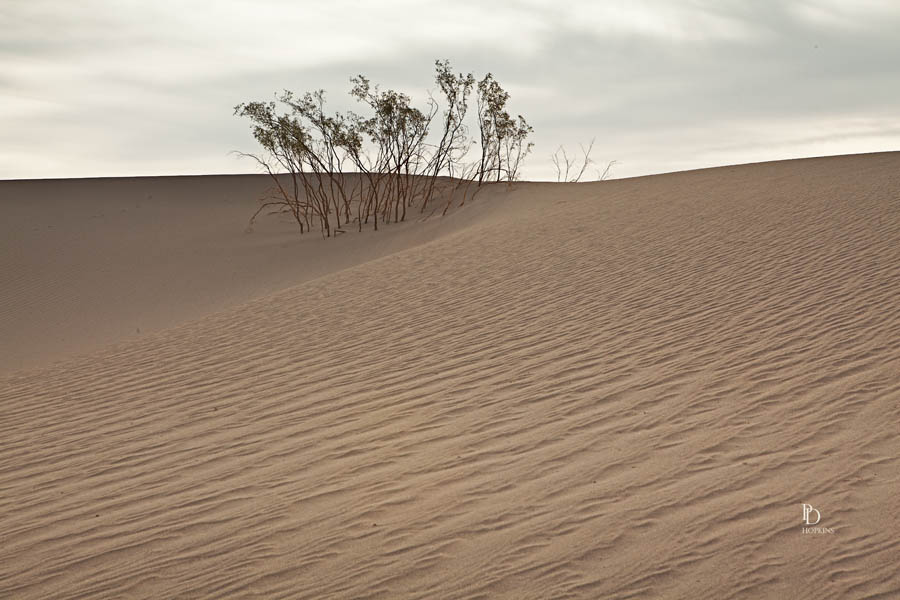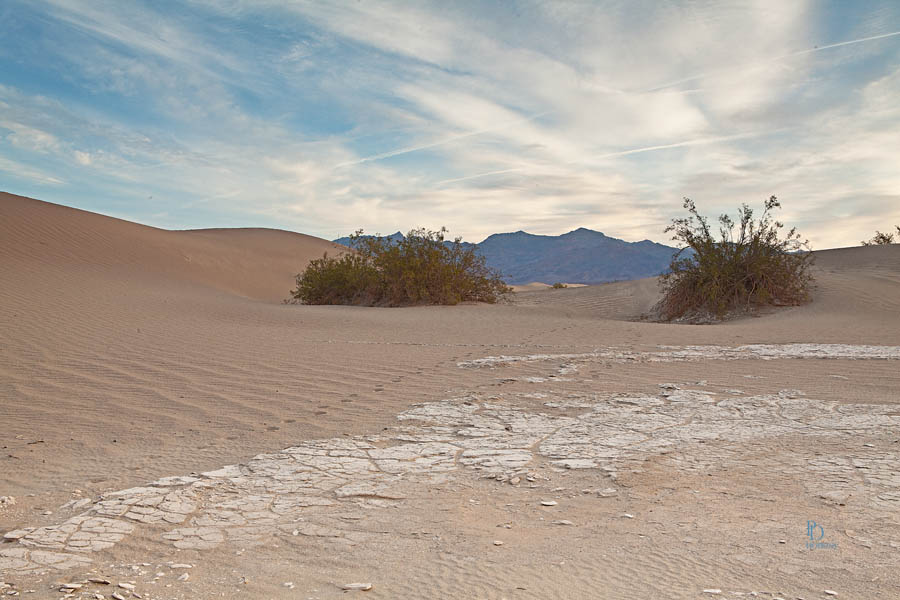Mesquite Dunes is an area of Death Valley National Park where, as the name implies the landscape is one of sand dunes we typically associate with a desert. It was my favourite area of the park, very picturesque and an excellent subject for photography.
Less than one percent of the Death Valley desert is covered with dunes, yet the shadowed ripples and stark, graceful curves define “desert” in our imaginations.
For dunes to exist there must be a source of sand, prevailing winds to move the sand, and a place for the sand to collect. The eroded canyons and washes provide plenty of sand, the wind seems to always blow (especially in the springtime), but there are only a few areas in the park where the sand is “trapped” by geographic features such as mountains.
The Mesquite Dunes are the best known and easiest to visit in the national park. Located in central Death Valley near Stovepipe Wells, access is from Hwy. 190 or from the unpaved Sand Dunes Road. Although the highest dune rises only about 100 feet, the dunes actually cover a vast area. This dune field includes three types of dunes: crescent, linear, and star shaped. Polygon-cracked clay of an ancient lakebed forms the floor. Mesquite trees have created large hummocks that provide stable habitats for wildlife.
This first shot is probably my favourite of those I took at Mesquite Dunes. A very simple scene that conveys the barren, sandy expanse of sand which despite being a harsh environment, sustains life.

My second picture captures a broader view showing many of the features that define the Mesquite Dunes area. You can see the Amargosa mountain range in the distance, part of the enclosure that contains the sand in this area. In the foreground you see the polygon-cracked clay of an ancient lakebed that forms the floor of the desert. And, of course the hardy shrubs that provide shade for the many species of animals and birds that eke out an existence among the dunes. The presence of humankind is also evident. I found it difficult at times to get a photograph without footprints in the sand, mine included! And in the sky, aircraft contrails piercing the cloud formations. These signs are transitory however; wind soon obscures the footprints and blows away the contrails.

Despite those few minor challenges, I was able to get many pictures that I like. Rather than ramble on about them, I’ve included a slideshow to share with you the beauty of the desert that I experienced.
For those who may be interested, a few short comments on how I took the pictures. They were all taken between 7:00 and 8:30 am, beginning with very subdued light, just after sunrise. I operated the camera in aperture priority mode to enable me to choose the aperture size and thereby control the depth of field. For landscapes such as these, a small aperture is needed for a greater depth of field. I worked with the aperture between f22 and f16. In low light conditions particularly, these small apertures require longer exposure times to get the picture, generally in excess of 1 second. I used a tripod to steady the camera; it’s pretty difficult to hand hold it steady enough for that long to achieve the sharpness desired. Because I wasn’t concerned about the duration of the exposure, I prefer to set the sensor sensitivity low at 100 ISO.
Because the contrast between the bright sky and the darker foreground is so great, I used a neutral density gradient filter (2 stops) to balance the exposure between the upper and lower parts of the image. This way I avoid underexposure of the dark areas of the picture and overexposure of the light areas.
I did some minor touch-ups in Photoshop, some colour saturation and sharpening to arrive at the final images.


Incredible!!